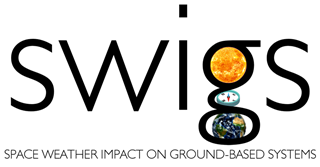SWIGS
Space Weather Impact on Ground-based Systems (SWIGS)
- Start date
- 1 May, 2017
- End date
- 30 April, 2021
Certain ground based technologies, such as electrical power grids, pipelines and railways are susceptible to the effects of Space Weather. Changes in the way the magnetic fields of the Sun and Earth interact with each other will drive electrical currents in the upper atmosphere; these varying currents will induce a varying magnetic field at ground level, which in turn leads to Geomagnetically Induced Currents (GIC) to flow to and from the ground through the networks named above.
GIC can disrupt the safe operation of power transformers and lead to increased rates of corrosion in pipelines. The potential cost of these effects of severe space weather is estimated to be in the billions of dollars per day! This hazard from space weather relies on
several factors
- the strength and characteristics of the space weather driver
- the variability of the upper atmosphere
- the electrical conductivity of the ground around the network
- the particular characteristics of the network
To properly understand GIC and provide a means of mitigating against them, requires addressing all of these factors with a multi-disciplinary approach and for scientists to work with the relevant indutries.
SWIGS is a £3M, four year NERC funded consortium of 10 institutes, 21 researchers and 7 post-docs. The consortium is led by the British Geological Survey (BGS) and brings together space physicists, solid-Earth geophysicists and upper atmospheric scientists. It involves expert project partners from around the world and works with key industries.
The BGS SWIGS project page is here

SWIGS is split into five cross-cutting work packages designed to address specific project aims.
- Work Package 1: Magnetospheric-Ionospheric Sources (MIS) of GIC
- Work Package 2: Solid Earth Response to MIS
- Work Package 3: Forecasting MIS and GIC processes
- Work Package 4: Infrastructure Impact of GIC
- Work Package 5: Management of Outputs, Reporting, Coordination and Outreach
BAS leads Work Package 1 in collaboration with partners at RALSpace and MSSL and is involved in work package 3.
Work package 1 focuses on one link in the Space Weather to GIC chain, particularly on the sources that drive GIC within the Earths near-space environment. The three main questions that this work package will answer are:
- Are extreme space weather currents different to the norm? By definition they’re certainly bigger, but do they flow in new or different ways, or saturate?
- How important are substorms? Typically several times a day this space weather phenomenon creates some of the strongest electrical currents in space but do they create the most hazardous GICs in electricity supply networks?
- Are big or little current systems the greatest hazard? Some evidence suggests that smaller-scale currents in space are hazardous but we don’t understand them very well – How are they caused? Can they be predicted from the large-scale currents that we understand and can predict better?
These questions will be answered using data collected by spacecraft operated by the European Space Agency, NASA, and others, and from international networks of instruments on the ground. The outcome will help focus work on developing models and other tools to forecast and mitigate the effects of GICs on the National Grid and other electricity supply networks around the world.

Andrew Kavanagh
Middle Atmosphere Vertical Coupling Analyst
BAS Science Management Team, BAS-Arctic Working Group, Space Weather and Atmosphere team